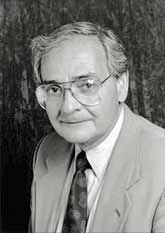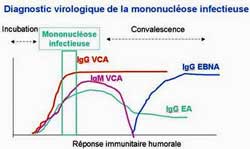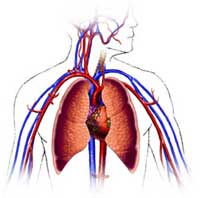Discuss this article on the forums
 Background: Dr. Lerner had quite a career before CFS. A check of his research record revealed over five decades of infectious disease work focusing on Coxsackie virus, herpes simplex virus, pseudomonas, interferon, Staphylococcus, Mycoplasma, enteroviruses, myocarditis, etc. A contributing author to one of the seminal works in the medical field – “Harrison’s Principal’s of Internal Medicine” – he’s published over 150 papers over the past fifty years.
Background: Dr. Lerner had quite a career before CFS. A check of his research record revealed over five decades of infectious disease work focusing on Coxsackie virus, herpes simplex virus, pseudomonas, interferon, Staphylococcus, Mycoplasma, enteroviruses, myocarditis, etc. A contributing author to one of the seminal works in the medical field – “Harrison’s Principal’s of Internal Medicine” – he’s published over 150 papers over the past fifty years.
In 1986 he began having troubles with dizziness and severe fatigue. A visit to the Cleveland Clinic found his heart was found to be grossly dilated. 10 years later he’d figured out how to treat himself recovered.In the meantime he did a 180 degree career turn and plunged, largely working alone, into wilderness of ME/CFS research. His first post-CFS paper in 1989 “A new continuing fatigue syndrome following mild viral illness” proposed that mild heart abnormalities involving T-waves in a group of post viral patients would be amplified greatly upon exercise and recommended that these patients not exercise vigorously. A 1993 paper cinched the T-wave problem and documented what he called a ‘subtle cardiac dysfunction’ that showed up response to normal everyday tasks. In a 1997 paper he proclaimed that “CFS is a persistent nonpermissive herpes virus infection of the heart”.A small 2001 study finding that antiviral therapy was indeed effective in CFS provided still more evidence for his theory.
In 2002 he documented a finding that would lay the foundation for his subsequent work – the presence of early gene products (for cytomegalovirus) in a subset of patients with CFS. 2002 would bring another successful small antiviral trial – this time using valacyclovir for 6 months in patients with Epstein-Barr virus infection. In 2004 he again documented the presence of early gene products in ME/CFS; this time to Epstein-Barr virus.He cemented his non-permissive infection hypothesis later that year when he demonstrated that abnormal heart wall motion and other problems were associated with incomplete replication of both viruses in CFS.
 A 36 month followup of his patients in 2007 indicated further progress on all fronts; the heart problems continued to decline, antibody levels felland he reported that many patients resumed normal activities. A 2008 paper validated the effectiveness of his Energy Point Index Score in measuring fatigue in ME/CFS.
A 36 month followup of his patients in 2007 indicated further progress on all fronts; the heart problems continued to decline, antibody levels felland he reported that many patients resumed normal activities. A 2008 paper validated the effectiveness of his Energy Point Index Score in measuring fatigue in ME/CFS.
Now Dr. Lerner has published his largest and most comprehensive study to date. While Dr. Lerner is an acknowledged pioneer in the antiviral field on CFS his theory’s have yet to gain acceptance outside of the immediate CFS community. Attempts to gets grants – not a problem at all in his pre-CFS career – have failed.. Will this paper finally translate into federal dollars for funding antiviral trials?Will it result in increased funding in this area? Only time will tell.
Did he regret turning his back on such a fertile career and journeying into the ‘desert’ of CFS research? With no funding publications came much less frequently post-CFS but Dr Lerner had no regrets at all saying ‘the work has been so fascinating that I just couldn’t stop”.He is clearly very excited about the possibilities present in the field.
Dr. Lerner’s study presents a culmination of his work with patients over the last ten years. This is not your typical 25 or 50 patient treatment trial. Virtually everyone he saw in his clinic over the past 10 years is in it. The study involved examining patient records every three months for the past 10 years – that’s ten years of replicated data. Ultimately it involved 7,000 patient visits that generated 35,000 fields of data.
While this is not the placebo controlled, double blinded treatment trial the research community loves it’s clearly dense with replicated data.
Findings: the paper presents some startling findings
- Long term antiviral therapy was effective – very effective – in many of his patients. Many of them, while not completely cured, are able to work and lead normal lives again – an astounding finding in this field. Some are completely cured.
- About 25% did not respond- a finding that may be related to the limited duration of their treatment.
- While Dr. Lerner’s protocol can and often does work for longer duration patients – duration of illness does make a difference in treatment response
- About 30% of his patients had, in addition to herpesvirus infection, another related infections such as Lyme disease, Babesia or Streptococcyus. The fact that these patients improved but not to the extent of herpesvirus only patients has profound implications for how to treat both ME/CFS and Lyme disease and other infected patients.
Spread – The CFS Community is a large and many people think a very varied one. I asked Dr. Lerner what percentage of patients that he saw fit into this herpesvirus/other pathogen infected subset?
Dr. Lerner replied that he thought about 90% of the patients that see him have this kind of pathogen involvement and that the reason the medical community doesn’t get it about the pathogen prevalence in ME/CFS is that they’re basically looking in the wrong place; if they start looking in the right place – that is, if they start looking for signs of ‘non-permissive infection’ he believes these results would show up in spades across the community.
In fact, Dr. Lerner believes that even he may be missing some significant pathogen involvement because we still don’t have a test for early gene products of HHV6. He noted that Dr. Kondo in Japan is trying to develop an antibody test for these. Once that test is developed it’s possible that the rate of HHV-6 infection in his cohort – which is quite low – could jump dramatically.
It’s possible, however, that Dr. Lerner’s reputation as an antiviral specialist has caused a more pathogenic subset of patients to make its way to him so it’s unclear at this point what percentage the CFS community it applies to. That fact demonstrates how desperately the CFS community needs studies that assess the prevalence of early herpesvirus gene products in CFS (as well as Borrelia, Babesia, etc). Ironically, the one group that’s been in a position to do this – theCDC’s CFS research program in the Rickettsial and Viral Diseases branch, no less -has virtually ignored pathogens in CFS for over the past decade.
In general a virus needs to do four things to spread an infection in the body.
- penetrate a cell
- use the cells machinery to build more viruses
- leave the cell and contact another cell or move into the bloodstream
- find another cell it can infect and start the process all over again.
- Problems with the second step of the process – using the cells machinery to create more viruses – are where non-permissive infections show up.
 Once they’re inside a cell viruses create a series of gene products or building blocks that are then pieced together to form the complete virus. In a nonpermissive infection the building block process gets stopped leaving the cells littered with bits of viral gene products. Dr. Lerner believes the herpesviruses in people with ME/CFS are able to create about a quarter of the building blocks needed to produce a new virus. He believes these viral gene products interfere with cell metabolism, weakening it and eventually probably causing it to die.
Once they’re inside a cell viruses create a series of gene products or building blocks that are then pieced together to form the complete virus. In a nonpermissive infection the building block process gets stopped leaving the cells littered with bits of viral gene products. Dr. Lerner believes the herpesviruses in people with ME/CFS are able to create about a quarter of the building blocks needed to produce a new virus. He believes these viral gene products interfere with cell metabolism, weakening it and eventually probably causing it to die.
Most viral tests look for antibodies to proteins found on the envelope of the virus. This makes sense in an normal infection because the immune system is usually interacting with the proteins on the outside surface the virus. But if the virus is pumping out hordes of early gene products such tests will miss any evidence of infection.
All the Way Well? You must’ve had wide range of responses. The average patient basically went from being out of bed for 4-6 hours a day (ie being in bed from 18-20 hours a day) to been able to maintain a 40 hour work week as well as light housekeeping or social activities. That’s an amazing functional shift. Since responders were classified as anyone who shifted at least one level upwards on the EIPS this suggests that some people must have shifted all the way to nine or 10; not only are they able to work but they are completely well, able to exercise without relapse, etc. Is that true?
Oh absolutely. I’ve got people who are up to 8 or 9 or 10; fully recovered able to exerciseand participate fully in life. I have all kinds of people who are not as well but are living normal lives now, marrying when they couldn’t marry before, working when they couldn’t work before. It’s been extraordinarily satisfying.
Dr. Lerner said that ‘viral load’ is a critical point and he pointed to what he described as a wonderful study showing that total viral load does diminish over time with Valtrex. He stated that ‘viral load’ (the number of viral particles present in the body) may be a function of duration for some patients; ie the longer the patient has been ill the higher their viral load. As a rule of thumb if somebody has been ill for three years or less they generally begin to respond within six months of starting antiviral therapy. Other patients will take longer; at the Clinic they suggest that patients be treated for at least a year before they assess how effective treatment is.
This is not to say that people who have been ill for seven or 10 or 15 years do not respond to this treatment; Dr. Lerner said many long-duration patients do respond to this treatment – but as a group they don’t respond as quickly and, of course, some don’t respond at all. About 25% of his patients were classified as nonresponders.
Another significant finding was that the nonresponders didn’t take the drugs for as long as the responders which suggested that some people simply needed to be on the drugs longer for the treatment effects to show up.
EBV replicates when the B cells it is found in divide – this is how it spreads from the original cell into the new cell. It reactivates – ie grows inside those cells – using an entirely different procedure.
 The primary treatment for EBV (either acyclovir or valtrex) is able to stop EBV reactivation; that is it is able to reach into the cell and stop the process which EBV uses to grow in the cell. Neither are able to stop EBV from replicating when the B cells its infected divide.
The primary treatment for EBV (either acyclovir or valtrex) is able to stop EBV reactivation; that is it is able to reach into the cell and stop the process which EBV uses to grow in the cell. Neither are able to stop EBV from replicating when the B cells its infected divide.
This is a problem because patients with high viral loads have many, many of their B cells infected with EBV, each of which is potentially a little time bomb waiting to go off if their immune system gets suppressed again. This could result in the classic get better, relapse, get better, relapse scenario that occurs as their stop EBVreactivation then allow it to reactivate as their systems get overwhelmed. Each time EBV reactivates enough to spread outside the cell the patients viral load increases (Dr. Lerner believes the herpesvirus infections in CFS are a mixture of permissive/nonpermissive infections).
Even if they knock EBV reactivation down are these people doomed to carrying increasingly high loads of EBV? Not necessarily. Because B-cells die off over time EBV is always in a race to keep infecting new cells before the cells it is present in die off. This means that if Valtrex can keep EBV reactivation down then as the infected B-cells die off the number of EBV infected cells should slowly decline over time.
This is what Cohen found in the paper Dr. Lerner liked very much. The decline in infected cells after Valtrex administration was slow, however; after a year only a modest decline has occurred. This ‘modest decline’ could be why really long-termantiviral therapy is sometimes necessary. Cohen estimated that it would take6 years of Valtrex administration every day to eradicate EBV from the B-cells (and 11 years to eradicate it completely from the body). Higher doses would work more quickly. Fortunately it’s more important to reduce EBV activity than to completely eradicate it. Most healthy people are, after all, infected with EBV and most patients should not require such long term treatment.
(Some healthy people do in fact carry high loads of EBV without any problem. These people, however, are able to hold EBV in check; if Dr. Lerner is right many CFS patients cannot).
Side Effects – I wondered about the side effects from such long term therapy.
Dr. Lerner said it’s important to be very careful with dosing but otherwise with an EBV infection it’s as simple as making sure that the patient is drinking enough water. With HMCV infection he has to be very careful with liver functioning tests since the antiviral can damage the liver but even so he’s had no really serious side effects.
Pathogen Plus Patients – One of the most significant findings was that unless physicians look for the full range of pathogens treatments for anyone pathogen may be not effective. About 30% of his patients had herpesviruses plus either Borrelia or Babesia and the patients with those infections simply did not thrive on a standard antivirals. Of course the same case can be made for Lyme patients; many patients undergo long antibiotic regimes but Dr. Lerner’s results suggest that if they have a herpes virus infection they most likely will not satisfactory results from antibiotic therapy. I asked him if he was surprised to see this subset popout. This finding could have profound implications for both sets of patients.
Dr. Lerner replied that he was ‘very, very surprised’ to see this pathogen+ group stick out. This was not a small subset of CFS patients – about 30% of his patients had ‘parasitic’ as well as ‘opportunistic’ infections. Most of these were Lyme disease (2/3rds Borrelia burgdorfii) with the rest either Babesia and/or Anaplasma (rickettsia) and/or streptococcal infections. These patients tended to be sicker (EIPS 3.1-4.0) and while after two and half years of treatment their EIPS scores were significantly improved (EIPS 5.3) they were still sick enough to be diagnosed with ME/CFS.
Dr. Lerner noted that the data is not so ‘bleak’ as it appears in the paper and that further directed treatment improved their outcomes considerably. Dr. Lerner’s assessment of the ‘bleakness’ of their treatment outcomes surprised me given their progress and surely reflected his high expectations; most physicians would be happy to see a jump from an EPIS score somewhere in the three’s (in bed about 20 hours a day) to the fives (performing with difficulty a sedentary job ). That kind of outcome is rarely seen in CFS treatment trials but Dr. Lerner clearly wanted to see more.
How did ‘parasitic’ infections show up in a disease mostly characterized by ‘opportunistic’ infections? Dr. Lerner could only speculate that the opportunistic infections had weakened the immune system enough to allow parasitic infections to gain entry.
The New Mantra – Data Mining, Data Mining, Data Mining – The ‘pathogen plus’ finding illustrated how important data mining is when you’re dealing with large amounts of data. The ability to tease out the herpesvirus plus patients had huge implications for the outcome of this study; if Dr. Lerner’s crew hadn’t statistically separated the pathogen plus group out the positive effects in the pure herpesvirus group would have partially disappeared.
This is a problem that presumably occurs in many studies. When you treat a ‘wastebasket disorder’ such as CFS as if it was a single disorder then the good responders are washed out by the non-responders which allows lower common denominator treatments like CBT (which would probably be somewhat effective in any chronic illness) to gain prominence.
In any case Dr. Lerner’s paper illustrates just how important ‘data mining’ is in uncovering patterns in complex, poorly characterized diseases like chronic fatigue syndrome and he’s fortunate to have a dedicated crew of volunteers with the skills necessary to do this kind of work. Providing Dr. Bateman with the tools to better mine her data was one reason the Phoenix Rising Fundraiser for the Fatigue Consultation Clinic took place.
It’s not surprising therefore that data mining plays such a key role in large data-rich enterprises such as the CFIDS Associations creation of its BioBank and DataBank and Research Network. Several of the CFIDs Associations current research projects use innovative techniques to mine large amounts data from multiple systems in order to find patterns that explain. Both the CFIDS Association and Whittemore Peterson Institute’s Biobanks should provide researchersopportunities to examine patient samples for factors like Dr Lerner has found.
Aftermath – What about when the responders go off the anti-retrovirals? They seem, on average, to be able to hold a job but exercise still seems to be problematic for many of them. Are they able to maintain their health off the antivirals? At some point do they need to do another round of antivirals? What is their prognosis post viral treatment?
Dr. Lerner stated that when his patients get well they tend to stay well. About 30% of them get up to eight or nine on the EIPS Scale and stay there. There’s another group there needs some ongoing viral suppression. He noted that he was on Valtrex for six years and is now off them entirely.
The Heart of It All? The heart infection Dr. Lerner proposes is present is unusual; in most heart infections the heart is grossly inflamed when dying cells explode into the bloodstream where their fragments attract hordes of immune cells that then touch off the inflammation seen in myocarditis or a typical heart infection.
In the nonpermissive infection Dr. Lerner envisions incomplete herpesvirus gene products disturbing heart cell functioning. Many of the infected cells probably do die off when the cell, recognizing that it’s been irrevocably damaged, flips on its suicide program but they do so at a rate that leaves them largely hidden from the immune system and inflammation is low.
 The heart replaces these cells with fibrous tissue – which means the damage is permanent. Stopping the infection, however, stops the slide to further damage to the heart and substantial recovery can occur – as evidenced by the improvement on the heart tests Dr. Lerner regularly gives.Patients may or may not fully recover their full extent of physical function – but after a point its not clear how much it matters. Dr. Lerner pointed to himself as an example; after 10 years of illness he probably sustained some permanent damage but it’s hard now to tell where; not many 80+ year olds are running a full-time medical practice, regularly traveling to international conferences, etc.
The heart replaces these cells with fibrous tissue – which means the damage is permanent. Stopping the infection, however, stops the slide to further damage to the heart and substantial recovery can occur – as evidenced by the improvement on the heart tests Dr. Lerner regularly gives.Patients may or may not fully recover their full extent of physical function – but after a point its not clear how much it matters. Dr. Lerner pointed to himself as an example; after 10 years of illness he probably sustained some permanent damage but it’s hard now to tell where; not many 80+ year olds are running a full-time medical practice, regularly traveling to international conferences, etc.
How do EBV and HCMV get carried to the heart when they’re present in a nonpermissive infection; ie if the herpesviruses are unable to create copies of themselves how are they getting out of the B cells and into the heart cells? In this paper Dr. Lerner stated that he believes that parts of the infection are permissive and that low levels of complete herpesvirus particles that are intermittently being carried to the heart; thus producing a smoldering infection that burns at a low heat.
OI and Low Blood Volume – What percentage of your patients have orthostatic intolerance (problems standing)? Does that clear up as well and if so do you have any idea what herpesviruses are doing to cause that problem? How about low blood volume?
Orthostatic intolerance (OI) – was a key symptom for Dr. Lerner when he became ill as it is for many ME/CFS patients. Some ME/CFS researchers think the autonomic nervous system plays the key role in OI but Dr. Lerner’s focus is on the heart. Over the years he’s documented several heart problems in his patients including aberrant Holter Monitor tests and abnormal cardiac wall motion findings.He believes that a heart weakened by these unusual infections beats more rapidly (the tachycardia in POTS) and ineffectively and this causes many of the problems many CFS patients have in standing up. He noted that these problems to clear up in the patients who respond to antiviral treatments.
Low blood volume – Dr. Lerner believes the low blood volume found in ME/CFS patients is an extraordinarily interesting finding but exactly what’s causing it is unclear. He did note that it could be protective in nature as it’s easier for the heart to function if there’s less pressure.
Other Markers? I wondered about other markers? There are lots of interesting immune and endocrine findings in CFS. Where any of these correlated with drops in antibody levels? Can Dr. Lerner see, for instance, the immune system or endocrine system readjusting itself?
Dr. Lerner acknowledged the importance of immune dysfunction in CFS but said he is not following any other immune markers in the illness and this makes sense. He is, after all, primarily a doctor treating his patients – most of whom have to pay for an expensive and long-term treatment regime (@$1,000/month) out of pocket. Without federal funding it’s hard to see how any physician can regularly collect nonessential data. Certainly one would think that immune functioning would be a part of any federally funded pathogen study
Future Drugs – The current crop of drugs went a long way but they didn’t work for some people, are expensive and require long treatment regimes; there’s still much work to be done on the antiviral front. I asked Dr. Lerner if he saw promise in any new or upcoming drugs?
He reported that Vistide (brand name)/Cidofiovir (generic) – was effective against HCMV but that he uses it only for the patients who have not responded to the standard protocol after at least 1 year because it can affect the kidneys.
- See Hammering CFS: A Vistide Success with Dr. Peterson for a report of a successful Vistide experience
He felt Marabavir is an interesting drug on the horizon. It still needs to be tested further but initial in vitro testing indicated it was effective against both HCMV and EBV and its safety profile looks very promising (which means that it may be able to be given in larger doses. Many drugs are a trade-off between side effects and effectiveness. If given in large enough quantities many drugs can kill off pathogens; the problem is that they can kill if the patient as well. Any ideal drug would be a drug safe enough to be able to give it in large enough quantities to quickly kill off the pathogens without harming the patient.)
- Dig Deeper! Valtrex in ME/CFS
- Dig Deeper! The Lerner Antiviral Treatment Paper
- Dig Deeper: A Four Part Series on EBV In ME/CFS
Future Work – I didn’t specifically ask Dr. Lerner about his future work but it’s clear that he’s very excited about the progress being made in the field and he’s actively pursuing his ideas. He said he plans to submit studies that will help to solidify the idea that ‘non-permissive’ viruses play a key role in ME/CFS (or as he says it ‘the chronic fatigue syndrome’).He hopes that a multi-center treatment trial will be done
The Martin Lerner Foundation – before the interview got started Dr. Lerner first acknowledged the people who created the Martin Lerner Foundation for the study of Chronic Fatigue Syndrome. It’s absolutely accurate to say that this paper would not have been created without their help. He first acknowledged Kim and Carol Gill, whom, if my notes are correct, created the Foundation in order to promote Dr. Lerner’s work. They and Jim Eddington spent a year and a half in the office developing the study. James Fitgerald at the Department of Medical Education at the University of Michigan Medical School did the statistics. Safadin Beqaj assisted in the creation of the paper . Ann Cavanaugh, the volunteer Communications Director for the Center (another CFS patient), was my liason.
In the end Dr. Lerner saw and treated his patients while a group of skilled volunteers snatched up his data, inputted it and then analyzed it and, in the end, presented it to him and that’s how this paper came about. He was very gratified by their work as should we all be.
Conclusion: This is not the paper that will cause the traditional medical community to turn its standard treatment approach to CFS on its head but it hopefully is the paper that will spur the creation of federally funded treatment trials and more research into the effects herpesvirus have on ME/CFS. This study cries out to put Dr. Lerner’s protocol to the test with double blinded, placebo-controlled, multicenter treatment trials and it is Dr. Lerner’s hope that is just what will happen.
